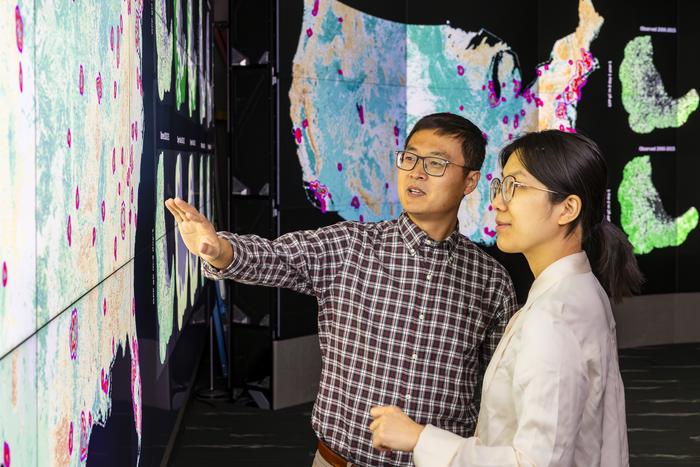Local decision-makers looking for ways to reduce the impact of heat waves on their communities have a valuable new capability at their disposal: a new study on vegetation resilience.

Credit: Carlos Jones, ORNL/U.S. Dept. of Energy
Local decision-makers looking for ways to reduce the impact of heat waves on their communities have a valuable new capability at their disposal: a new study on vegetation resilience.
Scientists at the Department of Energy’s Oak Ridge National Laboratory completed a study of how well vegetation survived extreme heat events in both urban and rural communities across the country in recent years. The analysis informs pathways for climate mitigation, including ways to reduce the effect of urban heat islands.
Vegetation such as trees provide a valuable cooling effect, shading surfaces and deflecting solar radiation while releasing moisture into the atmosphere through evapotranspiration — the process in which plants absorb water through their roots and release it as water vapor through their leaves.
The study, published in the journal PNAS Nexus, is the first nationwide accounting of vegetation resilience that takes into account the influence of human-built infrastructure. Using machine learning methods, ORNL researchers examined about two decades’ worth of satellite and other data covering 85 large cities and surrounding rural areas. The team found that impervious surfaces such as roads and other infrastructure, moisture conditions and type of land cover affect vegetation resilience. They also evaluated how vegetation is impacted by the intensity, duration and timing of heat waves.
The data provide crucial insights into how ecosystems can be guarded against climate change, including pathways to counteract the influence of urban heat islands and to improve the stewardship of natural resource areas, said Jiafu Mao, ORNL Earth system modeling scientist and the project’s lead.
“The empirical evidence we provide from this research can help urban planners better understand which plants are more vulnerable to heat waves and stressors such as water availability in the local environment, guiding decisions about plant selection and location and urban design improvements,” Mao said. “The study suggests that preserving and enhancing vegetation could significantly contribute to urban sustainability, air quality improvements and the well-being of residents.”
The work extends ORNL’s research on climate impacts in urban and rural ecosystems. In a previous study, Mao and colleagues found that while all regions of the country can expect an earlier start to the growing season as temperatures rise, the trend is likely to become more variable year over year in hotter regions. The research found a trend of accelerated spring budding and blooming of plants in rural areas as temperatures rise, for instance, but suggested the trend will slow as warming continues.
Identifying patterns to guide local decision-making
The new vegetation resilience study described in PNAS Nexus revealed a general trend of increased early greening in response to warmer temperatures in traditionally cooler months. But as temperatures soared and heat persisted, vegetation greening often significantly declined, said Yaoping Wang, an ORNL postdoctoral research associate and first author on the paper. The study identified a temperature of 2 degrees Celsius or higher above the historical summer average persisting for four months or more as the threshold for the most significant effects on greening.
Findings varied with local ecosystem characteristics. For instance, urban vegetation was found more resilient in the western United States than in the East during the analysis period, mainly because of higher urban growth temperatures and better irrigation practices in the West, the scientists noted.
“Our analysis is the first large-scale quantification of urban and rural differences in vegetation and its resilience to extreme events across the contiguous U.S., capturing these very broad patterns on environmental change,” Wang said. Future investigations that capture more high-quality data would benefit both urban planners and ecosystem modelers, she added.
The project provides valuable data on the complex interactions between biological and environmental factors at multiple scales over time, down to a 1-kilomenter resolution, Mao said. The information has also been used to fine-tune the land surface component that ORNL stewards for the DOE Energy Exascale Earth System Model, which simulates how the world may change in future climate scenarios.
The analysis used the Daymet4 database of daily land surface weather and climatological summaries, part of the ORNL Distributed Active Archive Center maintained for NASA’s Earth Science Data and Information System project. Scientists also leveraged the MODIS Enhanced Vegetation Index from NASA and the National Land Cover Database, maintained by the U.S. Geological Survey. The researchers used the random forest machine learning algorithm and other methods in their analysis, as well as the high-performance computing resources of the Oak Ridge Leadership Computing Facility, a DOE Office of Science user facility.
The project, titled, “Ecosystem Resilience to Thermal Extremes: Urbanization Impacts,” was supported by the ORNL Lab-Directed Research and Development program, the DOE Terrestrial Ecosystem Science Scientific Focus Area at ORNL, as well as the DOE Baltimore Social-Environmental Collaborative Integrated Field Laboratory project, sponsored by the Biological and Environmental Research program, part of the DOE Office of Science.
UT-Battelle manages ORNL for the Office of Science, the single largest supporter of basic research in the physical sciences in the United States. The Office of Science is working to address some of the most pressing challenges of our time. For more information, please visit https://energy.gov/science.
Journal
PNAS Nexus
Method of Research
Data/statistical analysis
Subject of Research
Not applicable
Article Title
Thermal, water, and land cover factors led to contrasting urban and rural vegetation resilience to extreme hot months
Article Publication Date
15-Apr-2024



